Honda S2000
| Honda S2000 | |
|---|---|
 | |
| Overview | |
| Manufacturer | Honda |
| Production | 1999–2009 |
| Designer | Daisuke Sawai (1996)[1] |
| Body and chassis | |
| Class | Sports car and roadster |
| Body style | 2-door roadster convertible |
| Layout | FMR layout |
The Honda S2000 was a roadster that was manufactured by Japanese automaker Honda from 1999 to 2009. First shown as a concept car at the Tokyo Motor Show in 1995, the production version was launched in April 1999 to celebrate the company's 50th anniversary. The S2000 is named for its engine displacement of two liters, carrying on in the tradition of the S500, S600, and S800 roadsters of the 1960s.
Several revisions were made throughout the car's lifetime, including changes to the engine, gearbox, suspension, interior and exterior. Officially two variants exist: the initial launch model was given the chassis code AP1, though cosmetically similar, the facelifted version (known as the AP2 in the US) incorporated significant changes to the drivetrain and suspension. Production of the S2000 ceased in June 2009. In Japan, it was exclusively sold through the Honda Verno sales channel.
Concept car
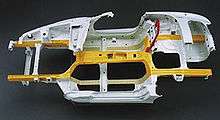
Introduced at the 1995 Tokyo Motor Show,[2][3] the Honda Sport Study Model concept car was the design study for the production S2000. The SSM was a rear-wheel-drive roadster powered by a 2.0 L (122 cu in) inline four-cylinder engine. It featured a rigid 'high X-bone frame' which Honda claimed improved the vehicle's rigidity and collision safety.[4] The concept car was constructed with aluminum body panels and featured a 50:50 weight distribution.[5]
The SSM appeared in many automotive shows for several years afterwards, hinting at the possibility of a production version, which Honda announced in 1999.
First generation (AP1 - 1999–2003)
| Honda S2000 (AP1) | |
|---|---|
|
| |
| Overview | |
| Production | 1999–2003 |
| Assembly | Takanezawa R&D Plant, Takanezawa, Tochigi, Japan |
| Body and chassis | |
| Class | Sports car, Roadster |
| Body style | 2-door convertible |
| Powertrain | |
| Engine | 2.0L I-4 F20C |
| Transmission | 6-speed manual |
| Dimensions | |
| Wheelbase | 94.5 in (2,400.3 mm) |
| Length | 162.2 in (4,119.9 mm) |
| Width | 68.9 in (1,750.1 mm) |
| Height | 50.6 in (1,285.2 mm) |
| Curb weight | 2,809 pounds (1,274 kg) |
The S2000 was introduced in 1999 for the 2000 model year and was given the chassis designation of "AP1". It features a front mid-engine, rear-wheel-drive layout with power delivered by a 1,997 cc (122 cu in) inline four-cylinder DOHC-VTEC engine. The engine (codenamed F20C) produces outputs of 177–184 kW (237–247 hp), and 208–218 N·m (153–161 lbf·ft) depending on the target market.[6] The engine is mated to a six-speed manual transmission and Torsen limited slip differential. The S2000 achieved what Honda claimed as "the world's top level, high performance four-cylinder naturally aspirated engine".[7]
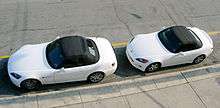
.jpg)
Features include independent double wishbone suspension, electrically assisted steering and integrated roll hoops. The car features 16 in (41 cm) wheels with Bridgestone Potenza S-02 tires. The compact and lightweight engine, mounted entirely behind the front axle, allow the S2000 to achieve a 50:50 front/rear weight distribution and lower rotational inertia. An electrically powered vinyl top with internal cloth lining was standard, with an aluminum hardtop available as an optional extra (in 2001). Honda offered Berlina Black, New Formula Red, Gran Prix White, Sebring Silver and Silverstone Metallic in the US domestic market.
The 2001 model was largely unchanged; Honda added a digital clock to the radio display and made the rear wind blocker standard. Honda also added Spa Yellow to the US domestic market lineup. For the 2002 model year, suspension settings were revised and the plastic rear window was replaced by a glass unit incorporating an electric defroster. Other updates included slightly revised tail lamps with chrome rings, an upgraded radio with separate tweeters, a leather gearshift knob, leatherette console cover and a revised engine control unit. Honda added Suzuka Blue to the US domestic market lineup.
The AP1 was manufactured up to 2003 at Honda's Takanezawa plant, alongside the Honda NSX and Honda Insight hybrid.[8]
Type V (Japan - 2000)
The Japanese domestic market received the Type V edition starting in mid-2000. It included variable gear ratio steering (VGS), a steering system that continuously changes steering ratio based upon vehicle speed and steering angle to provide improved handling. Honda announced the S2000 Type V on July 7, 2000 as the first system of its kind. The lock-to-lock steering ratio was reduced to 1.4 turns (stock is 2.4). Honda outfitted Type V cars with revised damper units, stabilizers and limited slip differentials to "complement the VGS". Equipped cars came with a special steering wheel and a VGS badge on the rear. [9] The Type V steering/handling package.
Second generation (known as "AP2" and in Europe as "AP1 facelift" - 2004–2009)
| Honda S2000 | |
|---|---|
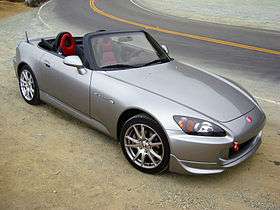 | |
| Overview | |
| Production | 2003–2009 |
| Assembly | Suzuka Plant, Suzuka, Mie, Japan |
The 2004 model S2000 underwent several significant changes. Production moved to Suzuka. The new model introduced 17 in (43 cm) wheels and Bridgestone RE-050 tires along with a retuned suspension to reduce oversteer. The spring rates and shock absorber damping were altered and the suspension geometry modified to improve stability by reducing toe-in changes under cornering loads. The subframe also received a revision in design to achieve a high rigidity. In the gearbox the brass synchronizers were replaced with carbon fiber. In addition, cosmetic changes were made to the exterior with new front and rear bumpers, revised headlight assemblies, new LED tail-lights, and oval-tipped exhausts. Although all the cosmetic, suspension and most drivetrain upgrades were included on the Japanese and European S2000s, they retained the 2.0l F20C engines and remained designated as AP1s.

For the North American market the updates also included the introduction of a larger version of the F20C (F22C1), this larger engine gave the chassis designation AP2. F22C1, the engine's stroke was lengthened, increasing its displacement to 2,157 cc (132 cu in). At the same time, the redline and fuel cutoff were reduced from 8,800 rpm and 9,000 rpm to 8,000 rpm and 8,200 rpm respectively, mandated by the longer travel of the pistons. Peak torque increased 6% to 220 N·m (160 lbf·ft) at 6,800 rpm while power output remained unchanged, 177 kW (237 hp) at a lower 7,800 rpm. In conjunction with its introduction of the F22C1, Honda also changed the transmission gear ratios by shortening the first five gears and lengthening the sixth.[10]
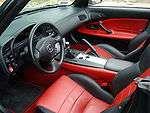
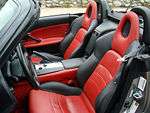
In 2006, the F22C1 was also introduced to the Japanese market, with slightly higher outputs (178 kW (239 hp) and 221 N·m (163 lbf·ft)). The F20C continued in all other markets. The 2006 model introduced a drive by wire throttle, an electronic stability control system, new wheels, and one new exterior color, Laguna Blue Pearl. Interior changes included revised seats and additional stereo speakers integrated into the headrests.
Club Racer (U.S. - 2008)
The 2007 model year marked the first time the S2000 was offered in more than one trim level in the United States.[11] In addition to the base model, Honda offered a more track-oriented version of the S2000, distinguished by reduced weight, fewer amenities, and an increase in performance. The S2000 Club Racer made its world debut at the New York International Auto Show on 4 April 2007.[12] Changes for the CR included a lower ratio steering rack, revised exhaust system, black lug nuts, darker colored wheels, clear side markers, stiffer suspension and new Bridgestone Potenza RE070 tires that were wider at the rear; 245/40R-17 to 255/40R-17. A revised body kit, composed of a redesigned front lip, and a large spoiler, were wind-tunnel tested and claimed to reduce the overall coefficient of lift by 70–80%. The power folding soft top was removed and replaced with additional chassis bracing topped off with a tonneau cover, while the hard top, optional on other models, became a standard feature on the CR. Honda also revised the shift knob over the base with an exclusive spherical aluminum shift knob that rests 12.6 mm lower for a 6 percent reduction in shift stroke compared to the conventional S2000 cylindrical shift knob (aluminum/leather wrapped). Conversely, the shift load effort increased by 10 percent with the new design.
CR models were only available with yellow and black alcantara interiors. Additionally the CR interior has faux carbon fiber overlays on the center console and radio door and a peak power indicator light on the instrument gauge cluster that flashes when the engine is producing its peak power output. Finally, in an effort to reduce weight and lower the center of gravity, the spare tire was omitted and air conditioning and stereo were offered only as options. Net weight savings without the additional hardtop came to 41 kg (90 lb) relative to the standard model. The engine in the S2000 CR was unchanged from the standard trim.[13][14] Shigeru Uehara, the designer of the S2000, stated that the CR was positioned between the Type S and a hypothetical Type R.[15] Honda has never made an official Type R for the S2000.
Production volume of fewer than 2,000 units was expected however the final number produced was 699 for the combined 2008 and 2009 model years. The production numbers were broken down as follows; Apex Blue Pearl: 200 (21 delete models) Rio Yellow Pearl: 140 (20 delete models) Berlina Black: 269 (10 delete models) Grand Prix White: 90 (8 delete models) for a total 699 (668 for 2008, 31 for 2009). Honda continued to offer both the standard and CR versions unchanged for the 2009 model year.
Type S (Japan - 2008)
The Japanese domestic market received the Type S edition for the last two years of production (2008-2009). Changes are similar to the U.S. market's CR edition, sharing the weight loss, a purpose built bodykit providing much higher downforce, bespoke wheels and interior. Although it shares the wheels with the CR edition, the Type S retains the rear tire size of 245/40R-17 for better handling. A specific Type S suspension setup with improved geometry was designed to enhance the handling, the setup is stiffer but more compromising than the CR setup to suit it better to everyday spirited driving and the Japanese touge experience.[16] The Type S retains its soft top folding mechanism.
The interior is a Type S specific yellow and black alcantara material scheme. Leather interior from the standard S2000 was available as a free option. The aluminum shift knob with reduced shift stroke is shared with the CR. While the CR is designed to be a pure track car, the Type S is designed for improved handling and retains some creature comforts.[17] Only 1,755 copies of the Type S was made and sold exclusively in Japan. (2007:168 units, 2008:827 units, 2009:737 units, 2010 [Jan-Jun]:23 units)
GT (U.K. - 2009)
In the United Kingdom, the 2009 model was offered in both roadster and GT trim. The GT featured a removable hard-top and an outside temperature gauge. On-the-road prices of these trims were £27,300 and £27,850 respectively.
Ultimate Edition and GT Edition 100 (Europe - 2009)
The S2000 Ultimate Edition (continental Europe) and GT Edition 100 (UK) were limited versions of the S2000 released to commemorate the end of production. Both included Grand Prix White body color, removable hard top, graphite-colored alloy wheels, and red leather interior with red coloring for stitching on the gear lever gaiter.
The Ultimate Edition was unveiled at the 2009 Geneva Motor Show and went on sale in March 2009.[18] The GT Edition 100 was a limited run of 100 units released for the UK market. In addition to the Ultimate Edition's specification, it features a black S2000 badge and a numbered plaque on the kick-plate indicating which vehicle in the series it is.[19]
Specifications
| 1999–2003 AP1 (F20C)[20] |
2004–2009 AP1 (F20C) |
2004–2009 AP2 (F22C1)[21][22] |
2008–2009 AP2 CR (F22C1)[22] | |
|---|---|---|---|---|
| Drivetrain | ||||
| Engine type | Naturally aspirated inline-4 | |||
| Displacement | 1,997 cc (122 cu in) | 2,157 cc (132 cu in) | ||
| Power | 177 kW (237 hp) @ 8,300 rpm (US & EU) 184 kW (247 hp) @ 8,300 rpm (JP) |
177 kW (237 hp) @ 7,800 rpm (US) 178 kW (239 hp) @ 7,800 rpm (JP) | ||
| Torque | 208 N·m (153 lbf·ft) @ 7,500 rpm (US & EU) 218 N·m (161 lbf·ft) @ 7,500 rpm (JP) |
220 N·m (162 lbf·ft) @ 6,800 rpm (US) 221 N·m (163 lbf·ft) @ 6,500–7,500 rpm (JP) | ||
| Redline / fuel cut-out | 8,800 rpm / 9,000 rpm | 8,000 rpm / 8,200 rpm | ||
| Bore & stroke | 87.0 mm (3.425 in) x 84.4 mm (3.323 in) | 87.0 mm (3.425 in) x 90.7 mm (3.571 in) | ||
| Compression ratio | 11.0:1 (US & EU) 11.7:1 (JP) |
11.1:1 | ||
| Valvetrain | 16-valve DOHC VTEC | |||
| Transmission | 6-speed manual | |||
| Gear ratios[23] | 1st: 3.133 2nd: 2.045 3rd: 1.481 4th: 1.161 5th: 0.970 6th: 0.810 Secondary gear reduction: 1.160 Final drive: 4.100 Reverse: 2.800 |
1st: 3.133 2nd: 2.045 3rd: 1.481 4th: 1.161 5th: 0.943 6th: 0.763 Secondary gear reduction: 1.208 Final drive: 4.100 Reverse: 2.800 | ||
| Dimensions[24] | ||||
| Weight | 1,250 kg (2,756 lb)
1,260 kg (2,778 lb) (JP type V) |
1,299 kg (2,864 lb) | 1,254 kg (2,765 lb) w/o AC
1,295 kg (2,855 lb) w/ AC | |
| Height | 1,270 mm (50.0 in) | 1,288 mm (51 in) | ||
| Width | 1,750 mm (68.9 in) | 1,750 mm (68.9 in) | ||
| Length | 4,135 mm (162.8 in) | 4,117 mm (162 in) | ||
| Wheelbase | 2,400 mm (94.5 in) | |||
| Tires | Bridgestone Potenza S-02 f: 205/55R16 89V r: 225/50R16 92V |
Bridgestone Potenza RE050 f: 215/45R17 87W r: 245/40R17 91W |
Bridgestone Potenza RE070 f: 215/45ZR17 87W r: 255/40ZR17 94W | |
| Wheels | f: 16x6.5" +55mm r: 16x7.5" +65mm |
f: 17x7" +55mm r: 17x8.5" +65mm | ||
| Brakes | f: 300 mm (11.8 in) ventilated discs r: 282 mm (11.1 in) solid discs | |||
Dimensions are approximate and vary across markets and years for the same model.
Reviews and awards
The S2000 has received much praise from critics and motoring journalists and has received favourable reviews from such publications as Car and Driver. Highlighted are the high output of the engine, the high redline, the balanced handling, and the smooth gearbox. User surveys have named the S2000 as a favorite for overall customer satisfaction.[25]
- The S2000 was on Car and Driver's 10Best list for 2000,[26] 2001,[27] 2002[28] and 2004.[29]
- The S2000 was the highest-ranked model in the J. D. Power and Associates Vehicle Dependability Study "Premium Sports Car" class for 2004,[30] 2006,[31] and 2008[32] and consistently held one of the top three positions.
- The S2000 was ranked number #1 in the BBC Top Gear survey in 2003, 2005, and 2006.
- The S2000 was ranked as "Best Affordable Sports Car" by U.S. News & World Report in 2008[33] and 2009[34]
- The S2000 was on Edmunds Consumers' Most Wanted Vehicles list for 2004,[35] 2005[36] and 2007.[37]
- The S2000 was one of Jalopnik's Best 10 Cars Of The Decade.[38]
- The S2000 was one of Road & Track's Best All-Around Sports Cars.[39]
Sales and production
After several years of steady production, sales of the roadster began falling dramatically starting in 2006, and the trend accelerated during the 2008 automotive industry crisis. In 2008, only 2,538 units were sold in the U.S. - a 74% decline from the 2002 sales peak. In November of that year, for the first time since its launch, only 90 new S2000s were sold nationwide during a calendar month.[40]
Production of the S2000 ceased in June 2009 [41] and plans for a successor were scrapped in the aftermath of the automotive industry crisis.[42] During the 2009 announcement of the vehicle's production end, Honda reported that worldwide sales through the end of 2008 totaled 110,673 units.[43]
| Calendar Year | U.S.[40][44] | Europe[44][45][46] | Japan[44][47][48] | Canada[44][49][50] | Australia[51][52][53][54][55] | New Zealand[56] | Middle East/Africa[57] |
|---|---|---|---|---|---|---|---|
| 1999 | 3,400 | 1,179 | 7,209 | 332 | 596 | ||
| 2000 | 6,797 | 3,955 | 3,422 | 412 | 521 | ||
| 2001 | 9,682 | 2,197 | 1,913 | 401 | 308 | ||
| 2002 | 9,684 | 2,537 | 1,471 | 336 | 164 | 10 | |
| 2003 | 7,888 | 2,095 | 961 | 238 | 79 | ||
| 2004 | 7,320 | 2,036 | 1,087 | 250 | 39 | ||
| 2005 | 7,780 | 1,795 | 981 | 212 | 40 | 8 | |
| 2006 | 6,271 | 1,474 | 1,225 | 146 | 30 | 3 | |
| 2007 | 4,302 | 1,116 | 997 | 123 | 26 | 6 | 126 |
| 2008 | 2,538 | 709 | 1,228 | 65 | 15 | 4 | 82 |
| 2009 | 795 | 680 | 1,122 | 49 | 2 | ||
| 2010* | 85 | 20 | 42 | 21 | |||
| 2011* | 5 | ||||||
| TOTAL | 66,547 | 19,793 | 21,658 | 2,585 | 1,818 | 33 | 208 |
*Note: No new cars were produced in 2010 and 2011; sales represent clearance of residual inventory.
Figures are not directly comparable as they are obtained through different methodologies in different markets.
References
- ↑ "Exterior body of a motor vehicle".
- ↑ "Honda S2000 - Introduction". Honda Media Newsroom. 2001-02-21. Retrieved 2013-06-20.
- ↑ "Honda Announces the S2000 Prototype". Honda Worldwide. 1998-09-24. Retrieved 2011-04-10.
- ↑ "Honda Introduces - a New Open Car Body Structure - Providing the Rigidity and Collision Safety of a Non-Convertible". Honda Worldwide. 1999-02-23. Retrieved 2013-06-20.
- ↑ "1995 Honda SSM Concept". Fast-Autos.net. Retrieved 2008-04-04.
- ↑ "Honda S2000 Fact Book". Honda Japan. 1999-04-15. Retrieved 2013-06-20.
- ↑ "Honda to Discontinue Production of the S2000 Sports Car". 2009-01-27. Retrieved 2013-06-21.
- ↑ Kazuhiko Tsunoda (August 2000). "Gaining New Insight Into Aluminum Body Production". Retrieved 2006-09-19.
- ↑ "TYPE V".
- ↑ "2004 Honda S2000 - Introduction Part 1". Honda Media Newsroom. 2003-01-10. Retrieved 2013-06-20.
- ↑ "Club Racer-Inspired Honda S2000 CR Prototype to Debut at New York International Auto Show". Honda Media Newsroom. Honda. 2007-03-13. Retrieved 2007-03-19.
- ↑ Lavrinc, Damon (2007-04-04). "Honda's hardcore S2000 is a fitting send off". Autoblog. Weblogs, Inc. Retrieved 2007-04-04.
- ↑ Mike Dushane (April 2007). "2008 Honda S2000 CR". Car and Driver. Retrieved 2007-04-18.
- ↑ "2008 Honda S2000 - Introduction". American Honda. 2007-08-15. Retrieved 2013-06-21.
- ↑ 2008 Honda S2000 CR: Shigeru Uehara talks with Inside Line. Edmunds. 2007-08-11. 1:04 minutes in. Retrieved 2013-06-21.
Probably the position of this vehicle is just between Type R and Type S
- ↑ "TYPE Sテクノロジー".
- ↑ Neff, John. "Officially Official: JDM-spec Honda S2000 Type S".
- ↑ "ASIMO Introduces the New Honda Insight Hybrid to Europe at the Geneva Motor Show". Honda Worldwide. 2009-02-05. Retrieved 2013-06-21.
- ↑ "Limited edition S2000 marks end of production". Honda UK Newsroom. 2009-01-30. Retrieved 2013-06-20.
- ↑ "S2000 Fact Book". Honda Motor Co., Ltd. (in Japanese). 1999-04-15. Retrieved 2009-03-17.
- ↑ "2008 Japan Honda S2000 engine specifications" (in Japanese). Honda Japan. Retrieved 2007-10-25.
- 1 2 "2008 Honda S2000 Specifications and Features". Honda Media Newsroom. Honda. 2007-08-15. Retrieved 2013-06-21.
- ↑ "2004 Honda S2000 - Powertrain Part 2". Honda Press & Media Centre. 2003-01-10. Retrieved 2009-05-19.
- ↑ "2009 Honda S2000 specifications". Honda. Retrieved 2013-06-20.
- ↑ "Driver Power 2006: top 10 cars". AutoExpress. 2006-03-21. Retrieved 2013-06-21.
- ↑ "2000 10Best Cars". Car and Driver. January 2000.
- ↑ Csaba Csere (January 2001). "2001 10Best Cars". Car and Driver.
- ↑ Csaba Csere (January 2002). "2002 10Best Cars". Car and Driver.
- ↑ Csaba Csere; Frank Markus; Tony Swan (January 2004). "2004 10Best Cars". Car and Driver.
- ↑ "2004 Vehicle Dependability Study". J.D. Power. Retrieved 2006-09-19.
- ↑ "2006 Vehicle Dependability Study". J.D. Power. Retrieved 2006-09-19.
- ↑ "2008 Vehicle Dependability Study". J.D. Power. Retrieved 2008-08-13.
- ↑ Hardigree, Matt (2007-12-17). "U.S. News & World Report Names Best Cars for 2008". Jalopnik. Gawker Media. Retrieved 2007-12-17.
- ↑ "U.S. News & World Report: Best Affordable Sports Cars for 2009". U.S. News & World Report. 2009-08-11. Retrieved 2009-08-11.
- ↑ "Edmunds.com Announces Consumers' Most Wanted Awards for 2004". 2007-11-26. Retrieved 2013-06-21.
- ↑ "Edmunds.com Announces Consumers' Most Wanted Vehicle Awards for 2005". 2007-11-26. Retrieved 2013-06-21.
- ↑ "Edmunds.com Announces Consumers' Most Wanted Vehicle Awards for 2007". 2007-11-26. Retrieved 2013-06-21.
- ↑ "Jalopnik's Best 10 Cars Of The Decade". Jalopnik. Gawker Media. 2009-12-15. Retrieved 2009-12-15.
- ↑ "Best All-Around Sports Car: Honda S2000 - Road & Track". 2005-02-16. Retrieved 2013-04-10.
- 1 2 "Honda Media Newsroom Releases - Sales". Honda News. American Honda. Retrieved 2009-06-02.
- ↑ "2009 Will Be Final Model Year of Production for Honda S2000". Honda Media Newsroom. Honda. Retrieved 2009-01-26.
- ↑ Dan Stevens (2009-01-06). "Honda axes high-end models". Autocar. Retrieved 2009-01-01.
- ↑ "Honda S2000 Ultimate Edition". Honda European Media Newsroom. 2009-01-29. Retrieved 2009-03-13.
- 1 2 3 4 "2007 Honda Fact Book" (PDF). Honda. Honda Motor Company. 2007-07-06. Retrieved 2008-09-25.
- ↑ "European Registrations by Model 1972–2004". Honda News. 2005-06-09. Retrieved 2008-09-25.
- ↑ "Honda Business Brief". Honda of Europe. Honda Motor Company. 2009-05-27. Retrieved 2009-06-02.
- ↑ "Honda Vehicle Sales in Japan". Honda News. 2005-06-09. Retrieved 2008-09-25.
- ↑ "WARD'S Japan Passenger Vehicle Sales by Company and Line (subscription required)". WARD's Auto. January 2009. Retrieved 2009-06-02.
- ↑ "Honda Vehicle Sales in Canada". Honda News. 2005-06-10. Retrieved 2008-09-25.
- ↑ "Canada Light Vehicle Sales by Nameplate (subscription required)". Automotive News. 2009-01-19. Retrieved 2009-06-02.
- ↑ "Snapshot". The Age. drive.com.au. 2004-11-11. Retrieved 2008-09-25.
- ↑ "VFACTS Dec 2005" (MS-Excel). FCAI. pressroom.com.au. 2006-01-05. Retrieved 2008-09-26.
- ↑ "Honda hatches a hot one". Sydney Morning Herald. drive.com.au. 2007-03-09. Retrieved 2008-09-25.
- ↑ "Honda Australia 2006 Sales Figures". caradvice.com.au. 2007-01-05. Retrieved 2008-09-25.
- ↑ "RIP: Honda S2000". drive.com.au. 2009-01-30. Retrieved 2009-06-01.
- ↑ "Motor Vehicle Registration Statistics". New Zealand Transport Agency. 2002–2009. Retrieved 2010-10-26.
- ↑ "Honda 2009 Geneva Motor Show PressPack" (MS-Word). Honda Motor Europe. Honda Motor Company. 2009-03-02. Retrieved 2009-06-02.
External links
| Wikimedia Commons has media related to Honda S2000. |
- Official Honda S2000 sites for the U.S. and Japan
- Honda S2000 at DMOZ